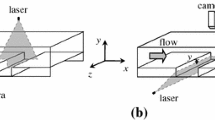Abstract
The flow through two facing, identical cavities (double-cavity) is characterized experimentally, as the inflow velocity and the distance between the cavities is varied. Standard 2D2C particle image velocimetry measurements in the spanwise mid-plane provide information on the instantaneous and mean velocity flow fields. Laser Doppler velocimetry measurements at several points in the double-cavity domain reveal the global character of the streamwise fluctuating velocity spectra. The flow is characterized based on time series, recorded in the shear layer of one of the cavities, for a wide range of inflow velocities and intercavity distances. In a detailed spectral study, we show how the shear layer spectra get affected when the two cavities are brought closer together. Based on the experimental data, a temporal local linear stability analysis was carried out, which was able to explain why the frequency peaks for close intercavity distances broaden and move to higher Strouhal numbers.


















Similar content being viewed by others
References
Alizard F, Robinet JC, Gloerfelt X (2012) A domain decomposition matrix-free method for global linear stability. Comput Fluids 66:63–84
Basley J, Pastur L, Lusseyran F, Faure T, Delprat: N (2010) Experimental investigation of global structures in an incompressible cavity flow using time-resolved PIV. Exp Fluids 50(4):905–918
Basley, J.: An experimental investigation on waves and coherent structures in a three-dimensional open cavity flow. Doctoral Thesis (2012)
Basley J, Pastur LR, Delprat N, Lusseyran, F (2013) Space-time aspects of a three-dimensional multi-modulated open cavity flow. Physics of Fluids 25
Bres G, Colonius T (2008) Three-dimensional instabilities in compressible flow over open cavities. J Fluid Mech 599:309–339
Chisari E, Artana G, Sciamarella D (2010) Vortex dipolar structures in a rigid model of the larynx at flow onset. Experiments in Fluids 397–406
de Vicente J, Basley J, Meseguer-Garrido F, Soria J, Theofilis V (2014) Three-dimensional instabilities over a rectangular open cavity: from linear stability analysis to experimentation. J Fluid Mech 748:189–220
de Vicente J, Basley J, Meseguer-Garrido F, Soria J, Theofilis V (2014) Three-dimensional instabilities over a rectangular open cavity: from linear stability analysis to experimentation. J Fluid Mech 189–220
Ho C, Huerre P (1984) Perturbed free shear layers. Ann Rev Fluid Mech 16:365–424
Huerre P, Monkewitz P (1985) Absolute and convective instabilities in free shear layers. J Fluid Mech 159:151–168
Huerre P, Rossi M (1998) Hydrodynamics and Nonlinear Instabilities. Camebridge University Press
Landau Lifschitz (1985) Physical Kinetics, Course of Theoretical Physics, vol 10. Robert Maxwell MC
Lusseyran F, Pastur L, Letellier C (2008) Dynamical analysis of an intermittency in open cavity flow. Physics of Fluids 20(114101)
Maurel A, Ern P, Zielinska BJA, Wesfreid JE (1996) Experimental study of self-sustained oscillations in a conned jet. Phys Rev E 54(4):3643–3651
Michalke A (1964) On the inviscid instability of the hyperbolic tangent velocity profile. J Fluid Mech 19:543–556
Morel T (1979) Experimental study of a jet-driven helmholtz oscillator. J Fluids Eng 101
Powell A (1953) On edge tones and associated phenomena. Acustica 3:233–243
Rockwell D, Naudascher E (1979) Self-sustained oscillations of impinging free shear layers. Ann Rev Fluid Mech 11:67–94
Rockwell D (1977) Prediction of oscillation frequencies for unstable flow past cavities. Trans ASME J Fluids Eng 294–300
Rossiter J (1964) Wind-tunnel experiments on the flow over rectangular cavities at subsonic and transonic speeds. Internal Report Ministry of Aviation 3438
Rowley CW, Colonius T, Basuz AJ (2002) On self-sustained oscillations in two-dimensional compressible flow over rectangular cavities. J Fluid Mech 455:315–346
Sarhia V (1975) Experimental and analytical investigation of oscillations in flows over cavities. PhD Thesis, p. 128
Sciamarella D, Quéré PL (2008) Solving for unsteady airflow in a glottal model with immersed moving boundaries. Eur J Mech B/Fluids 27(1):42–53
Tuerke F, Pastur L, Fraigneau Y, Sciamarella D, Lusseyran F, Artana G (2017) Nonlinear dynamics and hydrodynamic feedback in two-dimensional double cavity flow. J Fluid Mech 813:1–22
Tuerke F, Sciamarella D, Pastur LR, Lusseyran F, Artana G (2015) Frequency-selection mechanism in incompressible open-cavity flows via reflected instability waves. Phys Rev E 91
Villermaux E, Hopfinger E (1994) Effect of aspect ratio on the three dimensional global instability analysis of incompressible open cavity flows. Physica D 72:230–243
Welch PD (1967) The use of fast fourier transform for the estimation of power spectra: A method based on time averaging over short, modified periodograms. IEEE Transactions on Audio and Electroacoustics 15
Acknowledgements
We wish to acknowledge the support by the CONICET (Argentina) under Grant \(\#\)3303, UBACYT under grant \(\#\)100228, Science-Accueil d’Université Paris-Sud, LIA-PMF/FMF, and the 13STIC-08-P-MVP project of the SticAmSud program. Furthermore, Florian Tuerke greatly acknowledges the support of CONICET (Argentina), Université Paris-Sud & Université Saclay (France), Erich-Becker-Studienstiftung, and the DAAD (Germany).
Author information
Authors and Affiliations
Corresponding author
Electronic supplementary material
Below is the link to the electronic supplementary material.
Rights and permissions
About this article
Cite this article
Tuerke, F., Pastur, L.R., Sciamarella, D. et al. Experimental study of double-cavity flow. Exp Fluids 58, 76 (2017). https://doi.org/10.1007/s00348-017-2360-8
Received:
Revised:
Accepted:
Published:
DOI: https://doi.org/10.1007/s00348-017-2360-8




